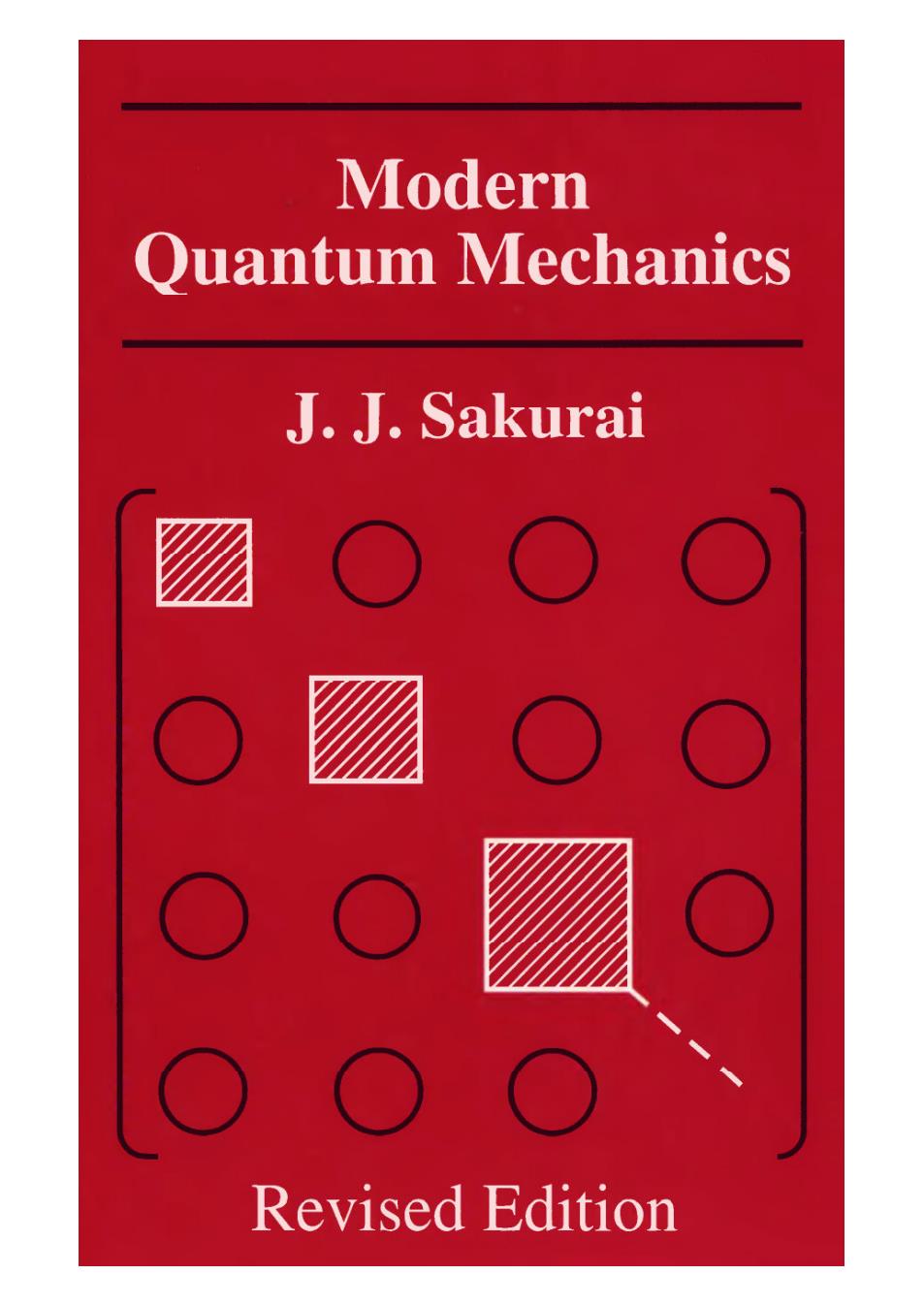
Modern Quantum Mechanics J.J.Sakurai Revised Edition
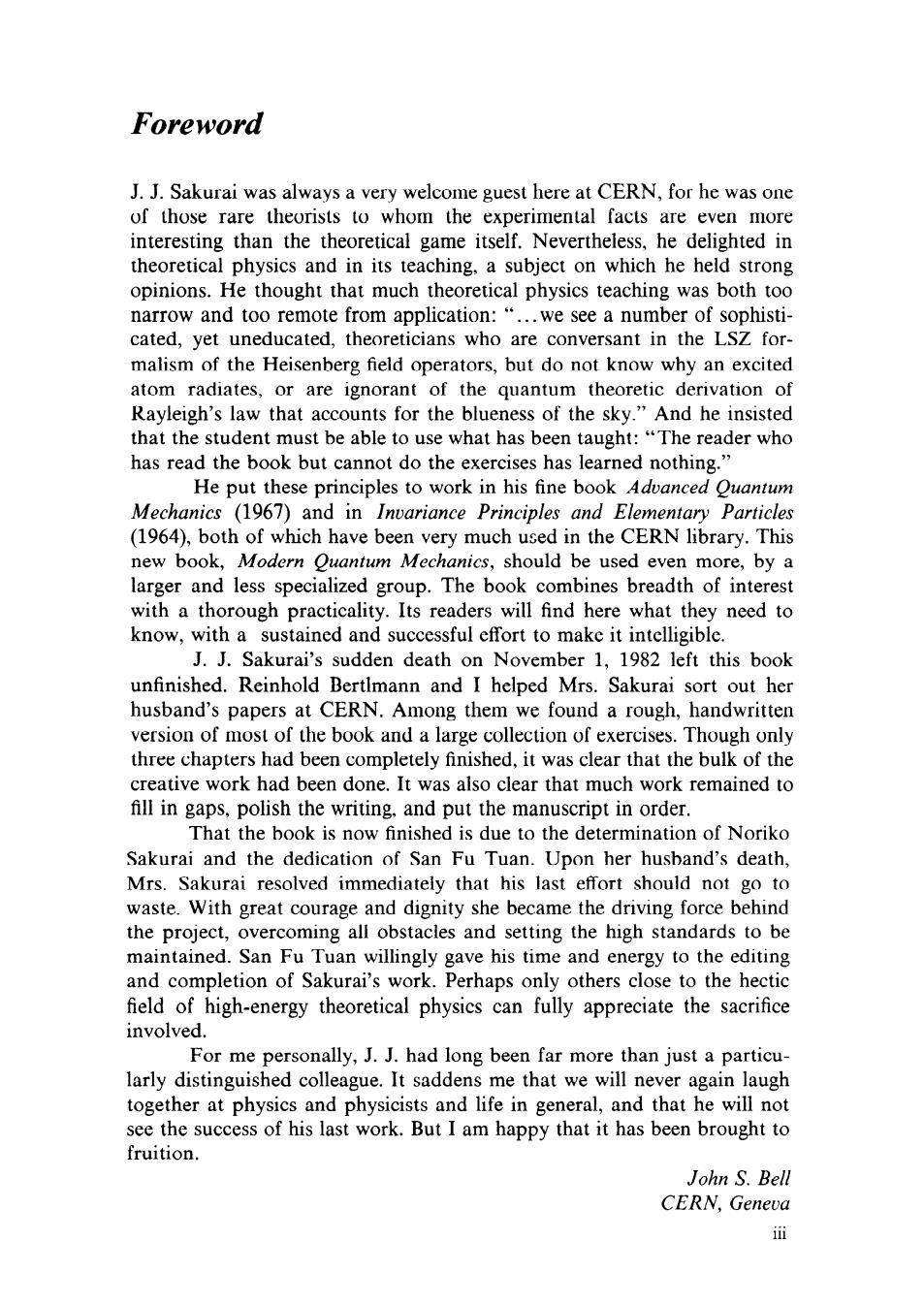
Foreword of those rare the interesting than the theoretical game itself.Nevertheless,he delighted in theoretical physics and in its teaching.a subject on which he held strong opinions.He thought that much theoretical physics teaching was both too na ..we see a number of so cated.vet uneducated.theoreticians who ars comversant in the Lsphisti for malism of the Heisenberg field operators,but do not know why an excited atom radiates.or are ignorant of the quantum theoretic derivation of Rayleigh's law that acco nts for the bluer ess of the sky."And he insisted that the nt use what has been taught ."The e rea der who has read the book but cannot do the exercises has learned nothing. He put these principles to work in his fine book Advanced Ouantum chamics (1967and in Invariamce Principles and Elementary Particles (1964),both of which have beer used in the CERN library. This new book,Modern Quantum Mechanics,should be used even more,by a larger and less specialized group.The book combines breadth of interest with a thorough practicality.Its readers will find here what they need to know,with a sustained and successful effort to make it intelligible. J.J.Sakurai' sudden death on November 1,1982 left this book unfinished.Reinhold Bertlmann and I helped Mrs.Sakurai sort out her husband's papers at CERN.Among them we found a rough,handwritten version of most of the book and a la e collection of exercis s.Though only three chapters had been completely finished.it was clear that the bulk of the creative work had been done.It was also clear that much work remained to fill in gaps,polish the writing.and put the manuscript in order. That the book is now finished is due to the determination of noriko Sakurai and the dedication of San Fu Tuan.Upon her husband's death Mrs.Sakurai resolved immediately that his last effort should not go to waste.With great courage and dignity she became the driving force behind the project,overcoming all obstacles and setting the high standards to be maintai ined.San Fu Tuan willingly gave his tim and er nergy to the editing completion of Sakurai's work.Perhaps on others cl e to the hectic field of high-energy theoretical physics can fully appreciate the sacrifice involved. For me rsonally,J.J.had long been far more than just a particu larly distingu It saddens me that we will never again laugh together at physics and physicists and life in general,and that he will not see the success of his last work.But I am happy that it has been brought to fruition. John S.Bell CERN,Geneva
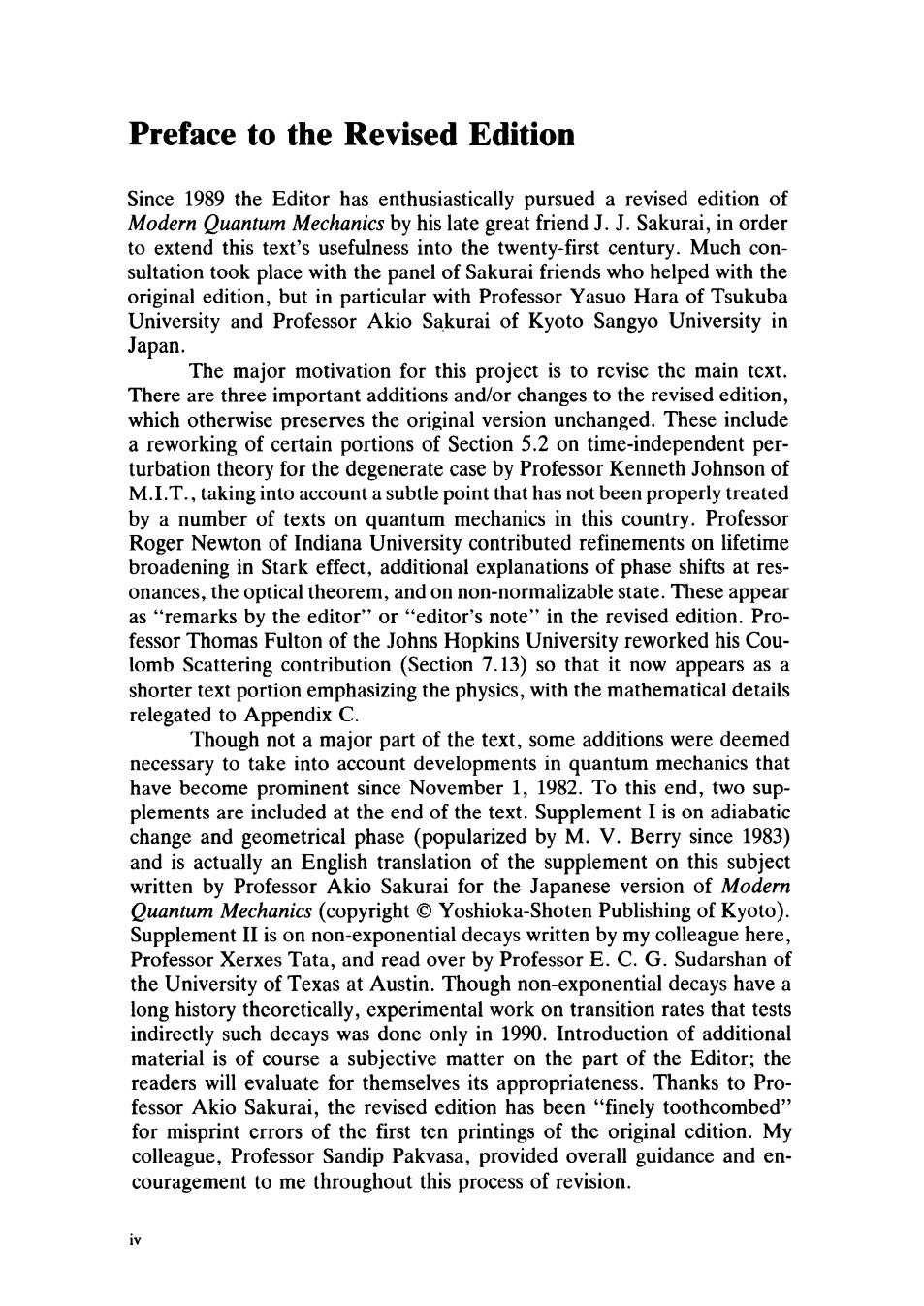
Preface to the Revised Edition Since 1989 the Editor has enthusiastically pursued a revised edition of Modern Quantum Mechanics by his late great friend J.J.Sakurai,in order to extend this text's usefulness into the twenty-first century.Much con- sultation took plac with the panel of Sakurai friendswho elped with the original edition,but in partic lar with Professor Yasuo Hara of Tsukuba University and Professor Akio Sakurai of Kyoto Sangyo University in Japan. The major motivation for this project is to rvisc the main text There are three important additions and/or changes to th vised edition which otherwise preserves the original version unchanged.These include a reworking of certain portions of Section 5.2 on time-independent per- turbation theory for the degenerate case by Professor Kenneth Johnson of M.I.T.,taking into account a subtle poin ot that ha snot been properly treated by a number of texts on quantum mechanics in this country.Professor Roger Newton of Indiana University contributed refinements on lifetime broadening in Stark effect,additional explanations of phase shifts at res- onances,the optical theorem,and on non-normalizable state.These appear as"rem arks by the edito or edit r's note in the revised editi fessor Thomas Fulton of the Johns Hopkins University reworked his Cou- lomb Scattering contribution (Section 7.13)so that it now appears as a shorter text portion emphasizing the physics,with the mathematical details relegated to Though not a major part of the text,some additions were deemed necessary to take into account developments in quantum mechanics that have become prominent since November 1,1982.To this end,two sup- mare inded at the end of the text.Supplementison a nge and rical phase (popularized by M.V.Berry since 1983) and is actually an English translation of the supplement on this subjec written by Professor Akio Sakurai for the Japanese version of Modern Quantum Mechanics(copyright Yoshioka-Shoten Publishing of Kyoto) pplement II is on nor onential decays written by my colleague here or Xerxe ata,and over by rofessor E. G.Sudar shan of the University of Texas at Austin.Though non-exponential decays have a long history theoretically,experimental work on transition rates that tests indirectly such decays was donc only in 1990.Introduction of additional material is of co urs subjectiv matter on the part of the Editor;the readers will evaluate for themselves its appropriateness.Thanks to Pro- fessor Akio Sakurai,the revised edition has been "finely toothcombed' for misprint errors of the first ten printings of the original edition.My colleague,Professor Sandip Pakvasa,provided overall guidance and en- couragement to me throughout this process of revision

Preface to the Revised Edition In addition to the acknowledgments above,my former students Li Ping,Shi Xiaohong,and Yasunaga Suzuki provided the sounding board for ideas on the revised edition hen taking my graduate qua ntum me chanics course at the University of Hawaii during the spring of 1992.Suzuki provided the initial translation from Japanese of Supplement I as a course term paper.Dr.Andy Acker provided me with computer graphic assis- tance.The Department of Phy sics and Astronomy and particularly the High Energy Physics Group of the University of Hawai at Manoa provided again both the facilities and a conducive atmosphere for me to carry out my editorial task.Finally I wish to express my gratitude to Physics (and onsoring)Senior Editor,Stuart Johnson,and his Editorial Assistant, Duggan,as well as Senior Production Coordinator Amy Willcut of Addison-Wesley for their encouragement and optimism that the revised edition will indeed materialize. San Fu TUAN Honolulu,Hawaii

In Memoriam Jun John Sakurai was born in 1933 in Tokyo and came to the United States as a high school student in 1949.He studied at Harvard and at Cornell, where he received his Ph.D.in 1958.He was then appointed assistant professor of Physics at the University of Chicago. and became a full professor in 1964.He stayed at Chicago until 1970 when he moved to the University of California at Los Angeles,where he remained until his death. During his lifetime he wrote 119 articles in theoretical physics of elementary particles as well as several books and monographs on both quantum and particle the The discipline of theoretical physics has as its principal aim the formulation of theoretical descriptions of the physical world that are at once concise and comprehensive.Because nature is subtle and complex,the pursuit of theoretical physics requires bold a and enthusiastic ventures to the frontiers of newly discovered phenomena.This is an area in which Sakurai reigned supreme with his uncanny physical insight and intuition and also his ability to explain these phenomena in illuminating physical terms to the Mechanics as well as his reviews and summer school lectures to appreciate this.Without exaggeration I could say that much of what I did understand in particle physics came from these and from his articles and private tutoring. When Sakurai was still a graduate student,he proposed what is now known as the V-A theory of weak interactions,independently of (and simultaneously with)Richard Feynman,Murray Gell-Mann,Robert Marshak,and George Sudarshan.In 1960 he published in Annals of Physics phetic paper,probably his single most important one.It wascon erned with the first serious attempt to construct a theory of strong interactions based on Abelian and non-Abelian (Yang-Mills)gauge invariance.This seminal work induced theorists to attempt an understanding of the mecha- nisms of mass generation for gauge(vector)fields.now realized as the Higgs mechanism.Above all it stimulated the search for a realistic unification o forces under the gauge principle,now crowned with success in the cel- ebrated Glashow-Weinberg-Salam unification of weak and electromagnetic forces.On the phenomenological side,Sakurai pursued and vigorously advocated the vector mesons dominance model of hadron dynamics.He was the first to discuss the mixing of and meson states.Indeed,he made numerous important contributions to particle physics phenomenology in a
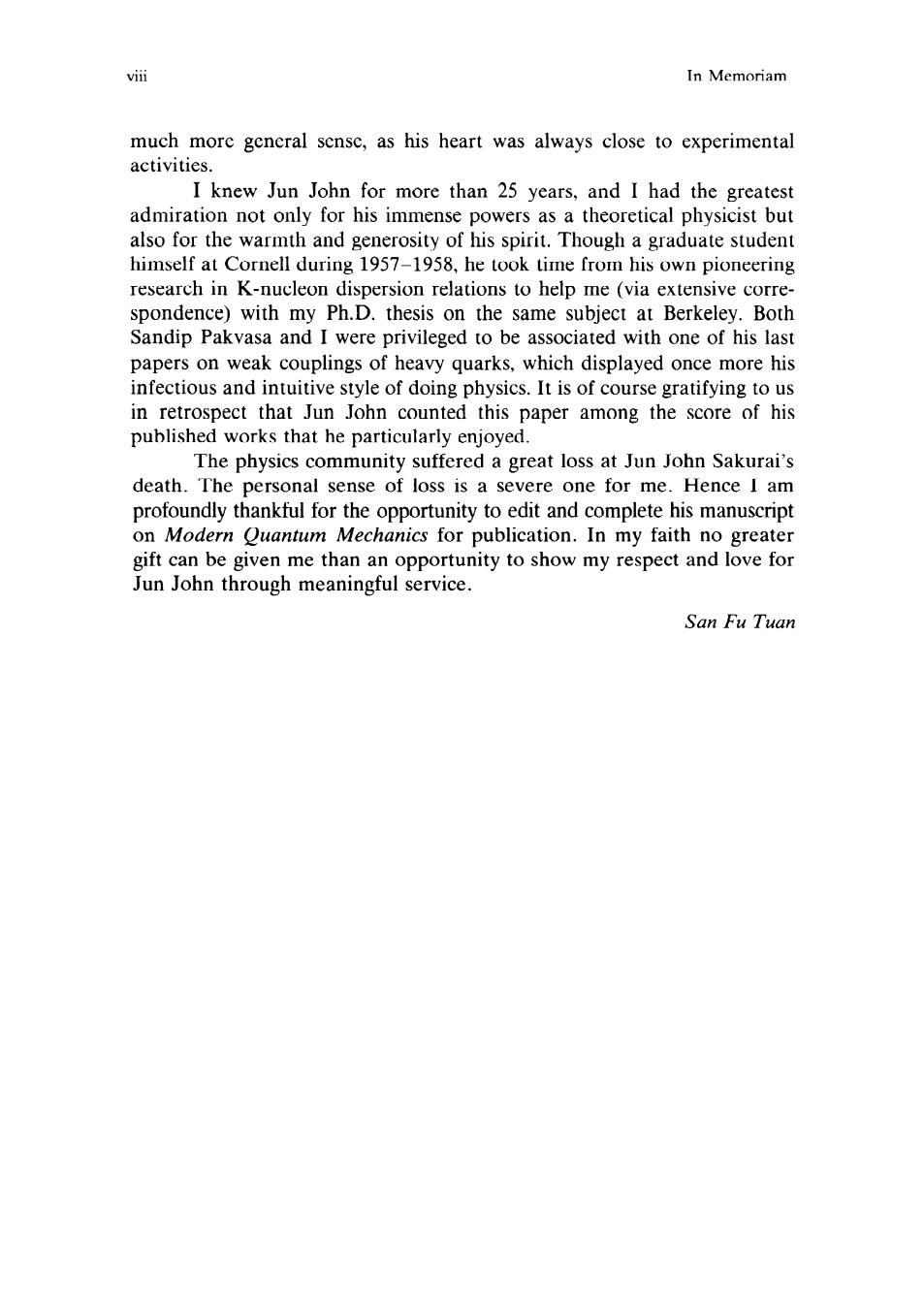
viⅷ In Memoriam much more general sense,as his heart was always close to experimental activities. I knew Jun John for more than 25 years,and I had the greatest admiration not only for his immense also for the himself at Cornell during 1957-1958,he took time from his own pioneering research in K-nucleon dispersion relations to help me (via extensive corre- spondence)with my Ph.D.thesis on the same subject at Berkeley.Both Sandip Pakvasa and I were privileged to be associated with one of his last papers on weak couplings of heavy quarks,which displayed once more his infectious and intuitive style of doing physics.It is of course gratifying to us in retrospect that Jun John counted this paper among the score of his published works that he particularly enjoyed. The physics community suffered a great loss at Jun John Sakurai's death.The personal sense of loss is a severe one for me.Hence I am profoundly thankful for the opportunity to edit and complete his manuscript on Modern Quantum Mechanics for publication.In my faith no greater gift an opp ortunity to show my respect and love for San Fu Tuan
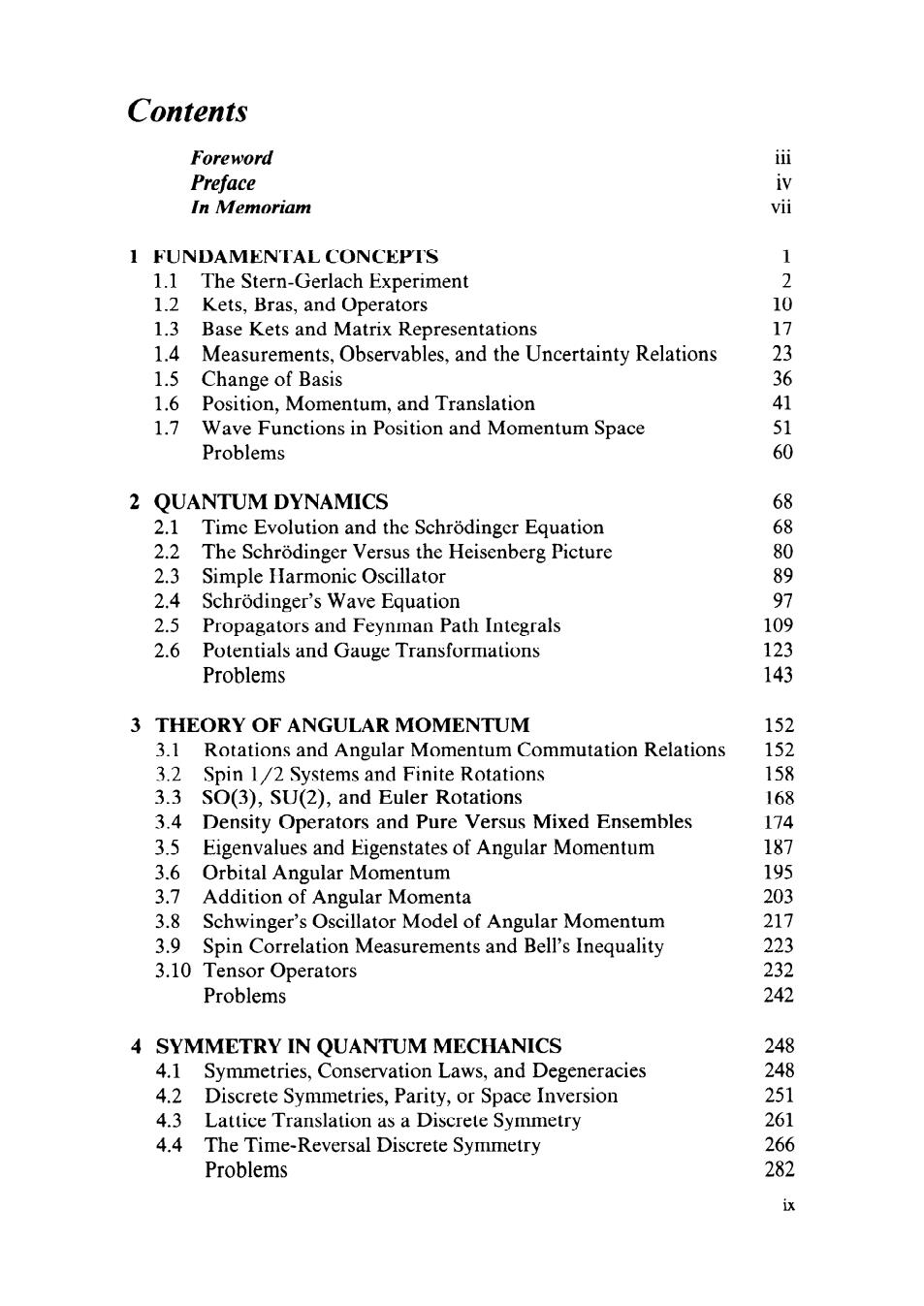
Contents Foreword Preface In Memoriam 1 FUNDAMENTAL CONCEPIS 1 1.3 Base Kets and Matrix Representations 1.4 Measurements,Observables,and the Uncertainty Relations 10723 15 Change of Basis 36 Positio n,Momentu and Translation 41 Wave Functions in Position and Momentum Space 1 Problems 60 2 QUANTUM DYNAMICS 6 2.1 Time Evolution and the Schrodinger Equation 68 2.2 The Schrodinger Versus the Heisenberg Picture 2.3 Simple Iarmonic Oscillator 2.4 Schrodinger's Wave Equation 97 2.5 Propagators and Feynman Path Integrals 2.6 Potentials and Gauge Transformations 193 Problems 143 3 THEORY OF ANGULAR MOMENTUM 3.1 Rotations and Angular Momentum Commutation Relations 3.2 Spin 1/2 Systems and Finite Rotations 12555 3.3 SO(3),SU(2),and Euler Rotations 168 3.4 Density Operators and Pure Versus Mixed Ensembles 174 Eigenvalues and Eigenstates of Angular Momentum 3.6 Orbital Angular Momentum 3.7 Addition of Angular Momenta 203 3.8 Schwinger's Oscillator Model of Angular Momentum 217 30 Spin Co relation Measurements and Bell's Inequality ))? 3.10 Tensor Operators 232 Problems 242 4 SYMMETRY IN QUANTUM MECHANICS 4.1 Symmetries,Conservation Laws,and Degeneracies 4.2 Discrete Symmetries,Parity,or Space Inversion 251 4.3 Lattice Translation as a Discrete Symmetry 261 44 The Time-Reversal Discrete Symmetry 266 Problems 282 4
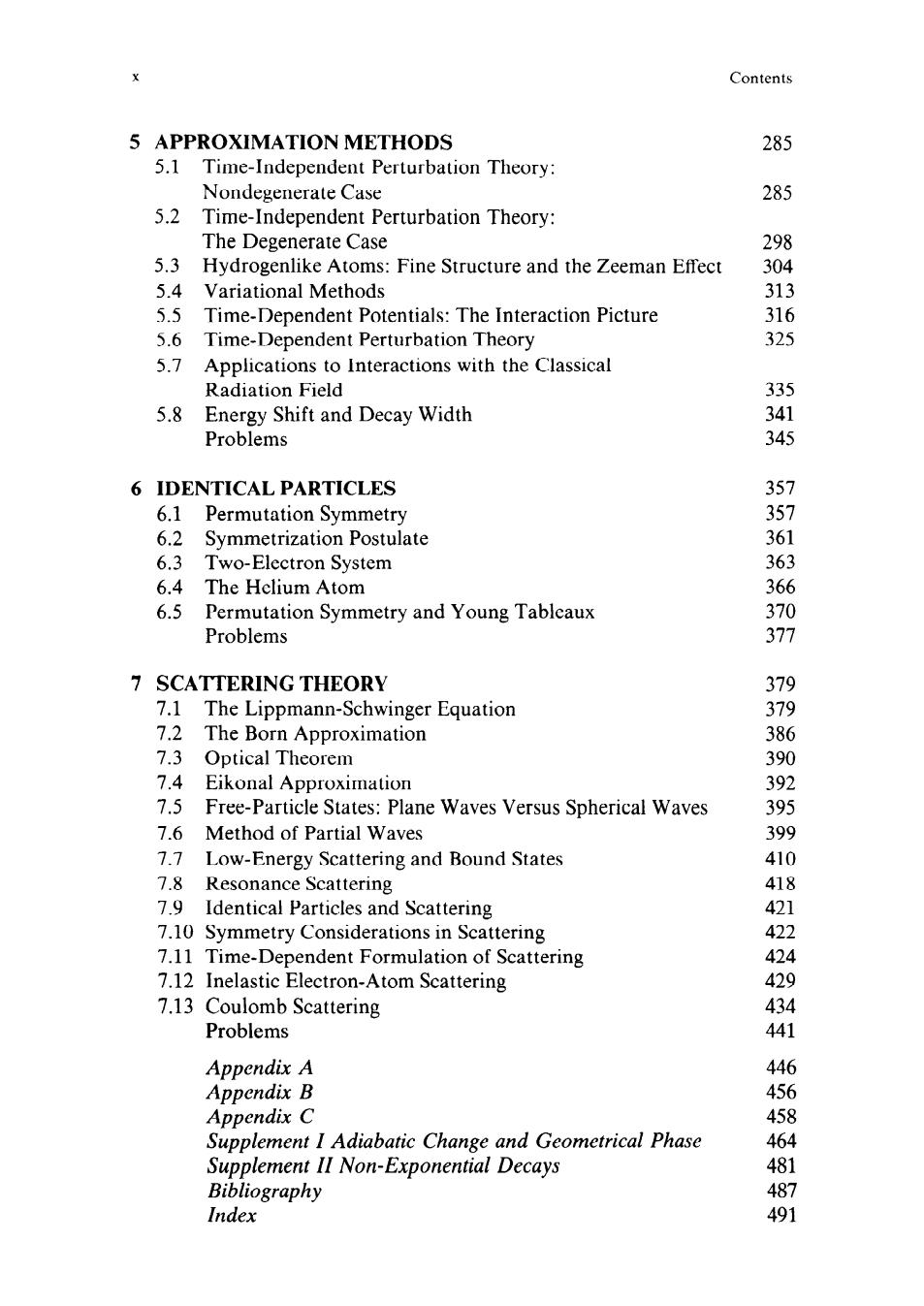
Contents 5 APPROXIMATION METHODS 285 5.1 Time-Independent Perturbation Theory: Nondegenerate case 285 5.2 Time-Independent Perturbation Theory The Degenerate Case 298 5.3 Hydrogenlike Atoms:Fine Structure and the Zeeman Effect 304 54 Variational Methods 313 55 Time-Dependent Potentials:The Interaction Picture 316 5.6 Time-Dependent Perturbation Theory 325 5.7 Applications to Interactions with the Classical Radiation Field 335 341 345 6 IDENTICAL PARTICLES 357 357 Symn 8 6.4 The Helium Atom 366 6.5 Permutation Symmetry and Young Tableaux 370 Problems 377 7 SCATTERING THEORY 379 7.1 The Lippmann-Schwinger Equation 379 7.2 The Born Approximation 386 7.3 Optical Thec em 390 74 Eikonal Approximation 7.5 Free-Particle States:Plane Waves Versus Spherical Waves 395 7.6 Method of Partial Waves 399 77 Low-Energy Scattering and Bound States 7.8 Resonance Scattering 418 7.9 Identical Particles and Scattering 42 7.10 Symmetry Considerations in Scattering 422 7.11 Time-Dependent Formulation of Scattering 424 7.12 Inelastic Electron-Atom Scattering 7.13 Coulomb Scattering Problems 441 Appendix B Appendix C Supplement I Adiabatic Change and Geometrical Phase Supplement II Non-Exponential Decays 481 graphy 487 Index 491
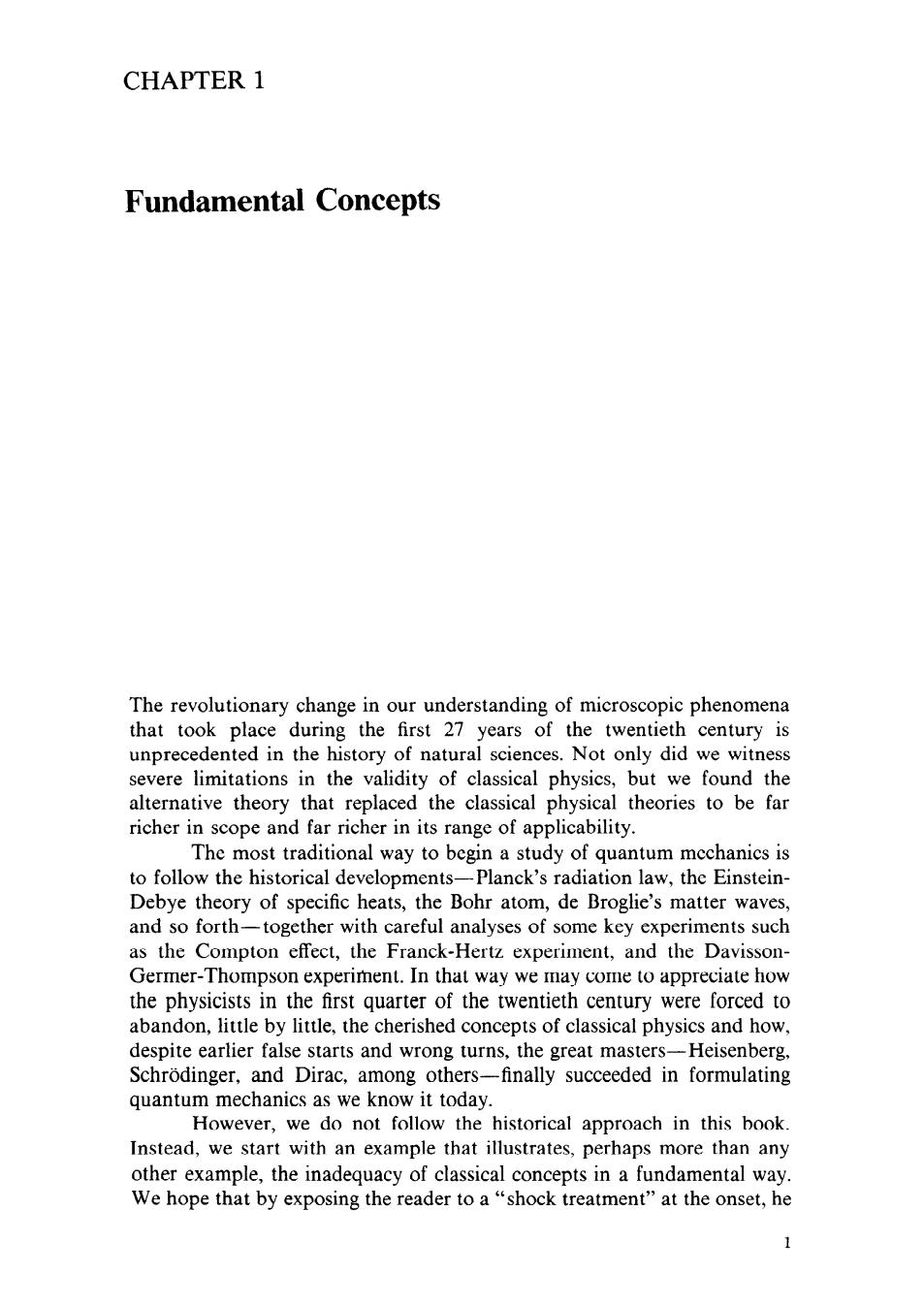
CHAPTER 1 Fundamental Concepts The revolutionary change in our understanding of microscopic phenomena that took place during the first 27 years of the twentieth century is unprecedented in the history of natural sciences.Not only did we witness severe limitations in the validity of classical physics,but we found the ernative theory that replaced the classical physic al theories to be far richer in scope and far richer in its range of applicability. The most traditional way to begin a study of quantum mechanics is to follow the historical developments-Planck's radiation law,the Einstein- Debye thec ry of sp cific heats,the Bohr atom ,de Broglie's matter wave and so forth-together with careful analyses of some key experiments such as the Compton effect,the Franck-Hertz experiment,and the Davisson- Germer-Thompson experiment.In that way we may come to appreciate how the physicists in the first quarter of the twentieth century were forced to abandon,little by little,the cherished concepts of classical physics and how despite earlier false starts and wrong turns,the great masters-Heisenberg. Schrodinger,and Dirac,among others-finally succeeded in formulating quantum mechanics as we know it todav. ever,we do not follow the historical approach in this book Instead,we start with an example that illustrates,perhaps more than any other example,the inadequacy of classical concepts in a fundamental way. We hope that by exposing the reader to a"shock treatment"at the onset,he
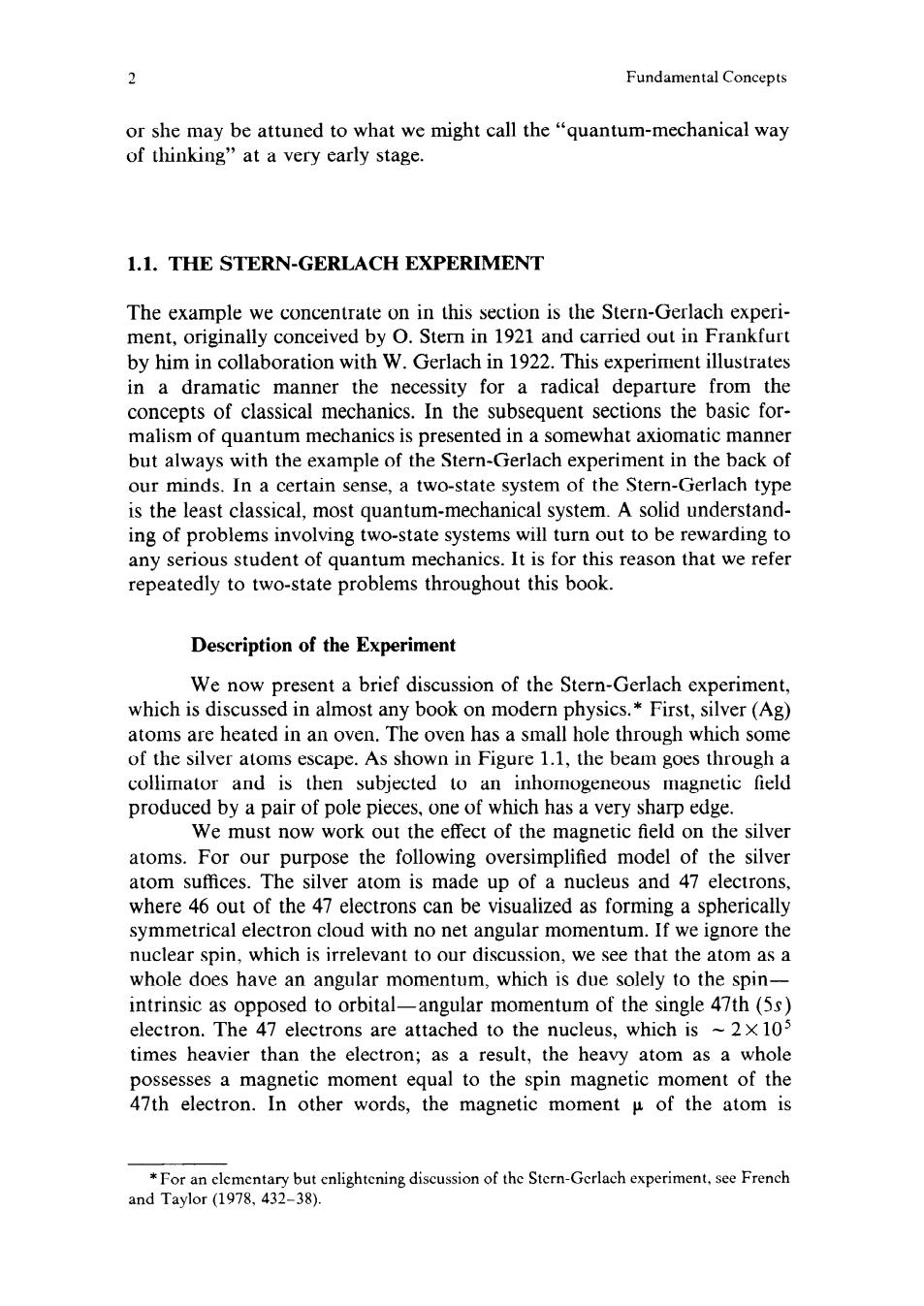
2 Fundamental Concepts or she may be attuned to what we might call the"quantum-mcchanical way of thinking"at a very early stage. 1.1.THE STERN-GERLACH EXPERIMENT The example we concentrate on in this section is the Stern-Gerlach experi- ment,originally conceived by O.Stern in 1921 and carried out in Frankfurt by him in collaboration with W.Gerlach in 1922.This experiment illustrate in a dramatic manner the necessity for a radical departure from the concepts of classical mechanics.In the subsequent sections the basic for- malism of quantum mechanics is presented in a somewhat axiomatic manner but alway vith the example of the Stern-Gerlach experiment in the back of our minds.In a certain sense,a two-state system of the Stern-Gerlach type is the least classical,most quantum-mechanical system.A solid understand- ing of problems involving two-state systems will turn out to be rewarding to any serious student of qua m mecha nics.It is for this reason that we refer repeatedly to two-state problems throughout this book Description of the Experiment We now present a brief discussion of the Stern-Gerlach experiment which is discussed in almost any book on modern physics.*First,silver(Ag) atoms are heated in an oven.The oven has a small hole through which some of the silver As sho re 1.1,the beam goes through a collimato and is then subjected to an nhomogeneous magnetic field produced by a pair of pole pieces.one of which has a very sharp edge. We must now work out the effect of the magnetic field on the silver atoms.For our purpose the following oversimplified model of the silver atom suffices.The atom is made e up of nucleus and 47 electron where 46 out of the 47 electrons can be visualized as forming a spherically symmetrical electron cloud with no net angular momentum.If we ignore the nuclear spin,which is irrelevant to our discussion,we see that the atom as a whole does have an angular momentum,which is due solely to the spin- intrinsic as opposed to orbital-angular momentum of the single 47th(5s electron.The 47 electrons are attached to the nucleus,which is ~2x 10 times heavier than the electron:as a result.the heavy atom as a whole possesses a magnetic moment equal to the spin magnetic moment of the 47h electron.In other words,the magnetic moment of the atom is *For an elen and Taylor (1978,432-38). y but enlightening discussion of the Stern-Gerlach experiment.see French